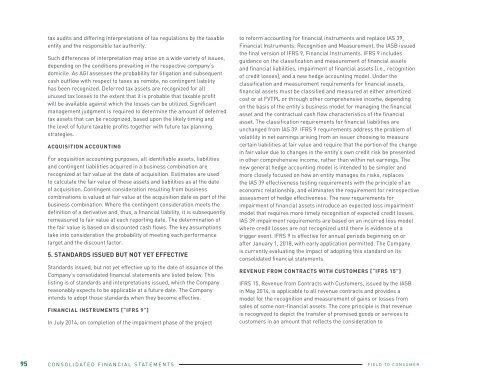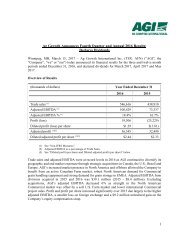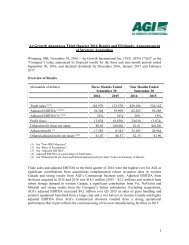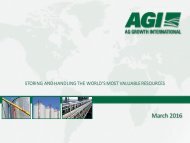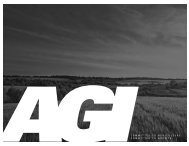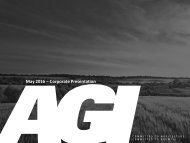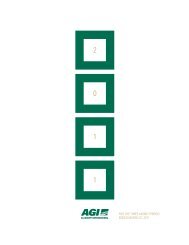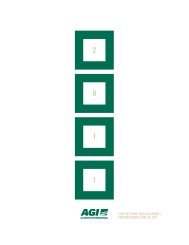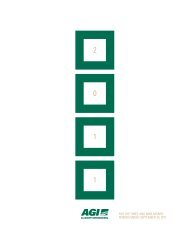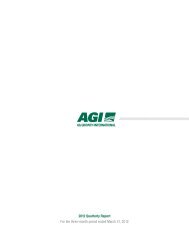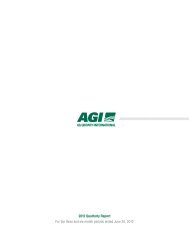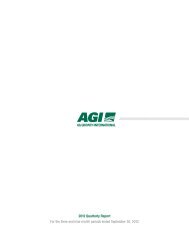2016 Annual Report For Web 7.3MB
You also want an ePaper? Increase the reach of your titles
YUMPU automatically turns print PDFs into web optimized ePapers that Google loves.
tax audits and differing interpretations of tax regulations by the taxable<br />
entity and the responsible tax authority.<br />
Such differences of interpretation may arise on a wide variety of issues,<br />
depending on the conditions prevailing in the respective company’s<br />
domicile. As AGI assesses the probability for litigation and subsequent<br />
cash outflow with respect to taxes as remote, no contingent liability<br />
has been recognized. Deferred tax assets are recognized for all<br />
unused tax losses to the extent that it is probable that taxable profit<br />
will be available against which the losses can be utilized. Significant<br />
management judgment is required to determine the amount of deferred<br />
tax assets that can be recognized, based upon the likely timing and<br />
the level of future taxable profits together with future tax planning<br />
strategies.<br />
ACQUISITION ACCOUNTING<br />
<strong>For</strong> acquisition accounting purposes, all identifiable assets, liabilities<br />
and contingent liabilities acquired in a business combination are<br />
recognized at fair value at the date of acquisition. Estimates are used<br />
to calculate the fair value of these assets and liabilities as at the date<br />
of acquisition. Contingent consideration resulting from business<br />
combinations is valued at fair value at the acquisition date as part of the<br />
business combination. Where the contingent consideration meets the<br />
definition of a derivative and, thus, a financial liability, it is subsequently<br />
remeasured to fair value at each reporting date. The determination of<br />
the fair value is based on discounted cash flows. The key assumptions<br />
take into consideration the probability of meeting each performance<br />
target and the discount factor.<br />
5. STANDARDS ISSUED BUT NOT YET EFFECTIVE<br />
Standards issued, but not yet effective up to the date of issuance of the<br />
Company’s consolidated financial statements are listed below. This<br />
listing is of standards and interpretations issued, which the Company<br />
reasonably expects to be applicable at a future date. The Company<br />
intends to adopt those standards when they become effective.<br />
FINANCIAL INSTRUMENTS [“IFRS 9”]<br />
In July 2014, on completion of the impairment phase of the project<br />
to reform accounting for financial instruments and replace IAS 39,<br />
Financial Instruments: Recognition and Measurement, the IASB issued<br />
the final version of IFRS 9, Financial Instruments. IFRS 9 includes<br />
guidance on the classification and measurement of financial assets<br />
and financial liabilities, impairment of financial assets [i.e., recognition<br />
of credit losses], and a new hedge accounting model. Under the<br />
classification and measurement requirements for financial assets,<br />
financial assets must be classified and measured at either amortized<br />
cost or at FVTPL or through other comprehensive income, depending<br />
on the basis of the entity’s business model for managing the financial<br />
asset and the contractual cash flow characteristics of the financial<br />
asset. The classification requirements for financial liabilities are<br />
unchanged from IAS 39. IFRS 9 requirements address the problem of<br />
volatility in net earnings arising from an issuer choosing to measure<br />
certain liabilities at fair value and require that the portion of the change<br />
in fair value due to changes in the entity’s own credit risk be presented<br />
in other comprehensive income, rather than within net earnings. The<br />
new general hedge accounting model is intended to be simpler and<br />
more closely focused on how an entity manages its risks, replaces<br />
the IAS 39 effectiveness testing requirements with the principle of an<br />
economic relationship, and eliminates the requirement for retrospective<br />
assessment of hedge effectiveness. The new requirements for<br />
impairment of financial assets introduce an expected loss impairment<br />
model that requires more timely recognition of expected credit losses.<br />
IAS 39 impairment requirements are based on an incurred loss model<br />
where credit losses are not recognized until there is evidence of a<br />
trigger event. IFRS 9 is effective for annual periods beginning on or<br />
after January 1, 2018, with early application permitted. The Company<br />
is currently evaluating the impact of adopting this standard on its<br />
consolidated financial statements.<br />
REVENUE FROM CONTRACTS WITH CUSTOMERS [“IFRS 15”]<br />
IFRS 15, Revenue from Contracts with Customers, issued by the IASB<br />
in May 2014, is applicable to all revenue contracts and provides a<br />
model for the recognition and measurement of gains or losses from<br />
sales of some non-financial assets. The core principle is that revenue<br />
is recognized to depict the transfer of promised goods or services to<br />
customers in an amount that reflects the consideration to<br />
which the entity expects to be entitled in exchange for those goods or<br />
services. The standard will also result in enhanced disclosures about<br />
revenue, provide guidance for transactions that were not previously<br />
addressed comprehensively [for example, service revenue and<br />
contract modifications] and improve guidance for multiple-element<br />
arrangements. IFRS 15 is effective for annual periods beginning on<br />
or after January 1, 2018, and is to be applied retrospectively, with<br />
earlier adoption permitted. Entities will transition following either a<br />
full or modified retrospective approach. The Company is currently<br />
evaluating the impact of the above standard on its consolidated financial<br />
statements.<br />
LEASES [“IFRS 16”]<br />
In January <strong>2016</strong>, the IASB released IFRS 16, Leases, to replace the<br />
previous leases Standard, IAS 17, Leases, and related Interpretations.<br />
IFRS 16 sets out the principles for the recognition, measurement,<br />
presentation and disclosure of leases for both parties to a contract,<br />
the customer [lessee] and the supplier [lessor]. IFRS 16 eliminates the<br />
classification of leases as either operating leases or finance leases and<br />
introduces a single lessee accounting model. IFRS 16 also substantially<br />
carries forward the lessor accounting requirements. Accordingly, a<br />
lessor continues to classify its leases as operating lease or finance<br />
leases, and to account for those two types of leases differently.<br />
IFRS 16 will be effective for the Company’s fiscal year beginning on<br />
January 1, 2019, with earlier application permitted only if the Company<br />
applies IFRS 15. The Company has not yet assessed the impact of the<br />
adoption of this standard on its consolidated financial statements.<br />
SHARE-BASED PAYMENT [“IFRS 2”]<br />
In June <strong>2016</strong>, the IASB issued amendments to IFRS 2, Share-based<br />
Payment, clarifying how to account for certain types of share-based<br />
payment transactions. The amendments provide requirements on the<br />
accounting for the effects of vesting and non-vesting conditions on the<br />
measurement of cash-settled share-based payments, share-based<br />
payment transactions with a net settlement feature for withholding<br />
tax obligations and a modification to the terms and conditions of a<br />
share-based payment that changes the classification of the transaction<br />
from cash-settled to equity-settled. The amendments apply for annual<br />
periods beginning on or after January 1, 2018. The Company is currently<br />
evaluating the impact of the amendments to IFRS 2 on its consolidated<br />
financial statements.<br />
6. BUSINESS COMBINATIONS<br />
[A] REM GRAIN VAC PRODUCT LINE<br />
Effective February 3, 2014, the Company acquired the assets related to<br />
the Rem Grain Vac product line [“Grain Vac”]. The acquisition of Grain<br />
Vac provides the Company with a complementary product line.<br />
During 2015, the allocation of the purchase price to acquired assets and<br />
liabilities was finalized. During <strong>2016</strong>, the conditions related to the cash<br />
holdback were met and the $250 of cash held in trust was released to<br />
the vendors.<br />
[B] VICWEST’S WESTEEL DIVISION<br />
Effective May 20, 2015, the Company acquired substantially all of the<br />
assets of Vicwest’s Westeel Division [“Westeel”], Canada’s leading<br />
provider of grain storage solutions. The acquisition of Westeel provides<br />
the Company with an expanded growth platform within North America<br />
and around the world.<br />
The purchase has been accounted for by the acquisition method with the<br />
results of Westeel included in the Company’s net earnings from the date<br />
of acquisition. The assets acquired and liabilities assumed of Westeel on<br />
the date of acquisition have been recorded in the consolidated financial<br />
statements at their estimated fair values as follows:<br />
95 CONSOLIDATED FINANCIAL STATEMENTS<br />
FIELD TO CONSUMER<br />
<strong>2016</strong> ANNUAL REPORT<br />
CONSOLIDATED FINANCIAL STATEMENTS 96


